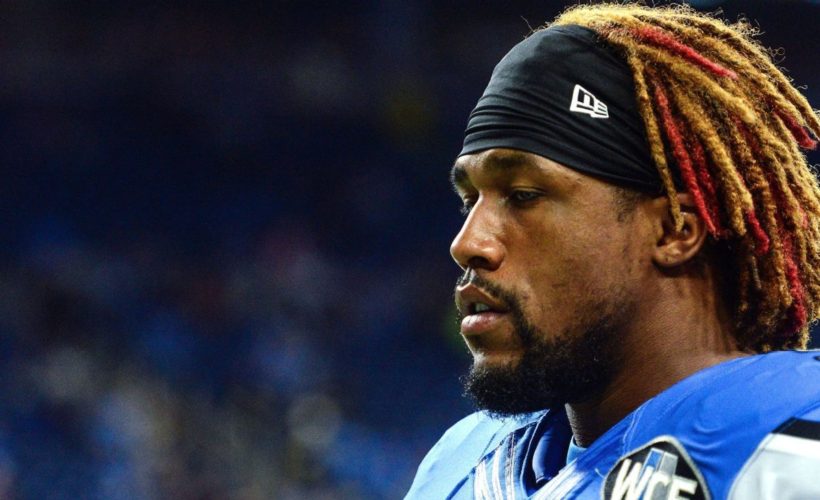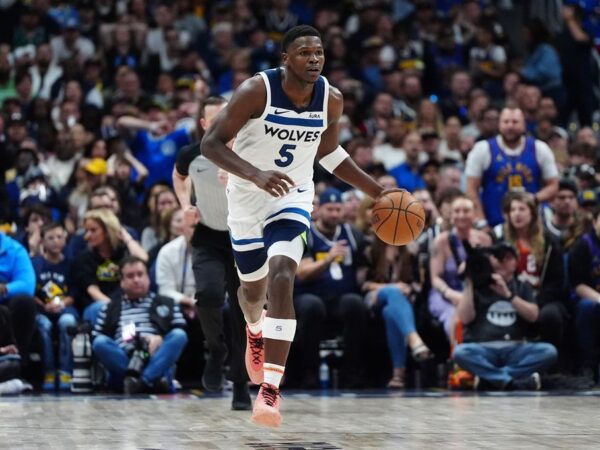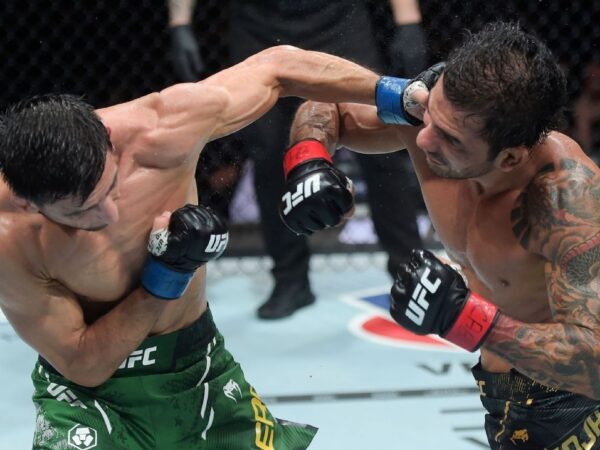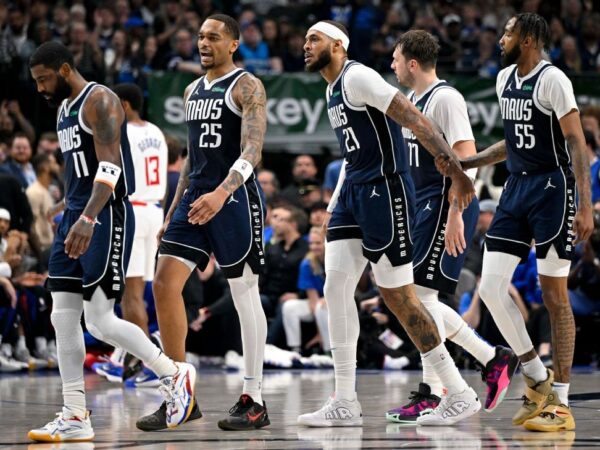Armonty Bryant wakes up every morning, gets out of bed and for most of the day can’t leave his bedroom. He wants to. He would give almost anything to. He must stay.
Bryant, 28, takes four pills for his blood pressure and gets to work. It’s a different job than the one he had before as an NFL defensive lineman who was drafted by the Cleveland Browns in 2013 and last played for the Detroit Lions in 2016. It’s one he doesn’t get paid for, but one he must complete in order to live.
He begins his arduous daily process here, starting with hanging a new bag of dialysis solution on his IV pole. For 50 minutes he sits in the San Diego bedroom he shares with his wife, Kim. He connects the solution to a catheter coming out of his abdomen. He then drains his body of the old solution that has been filtering his blood, a step that takes 15 to 20 minutes. Next he fills his abdomen with the new solution, completing a round of peritoneal dialysis. When the bag is empty, he gets up and caps it before he heads off to make breakfast and start his day.
Four hours later, he does it again, a daily loop of fluid, waste and frustration.
Wake up. Dialysis. Breakfast. Clean up. Dialysis. Clean, read or play FIFA or NBA2K. Dialysis. More cleaning, a visitor or whatever he can handle. Kim comes home. Dinner. Dialysis. Bed. Wake up.
Repeat.
During dialysis training in November, Bryant broke down in tears. He can’t work. Essentially homebound, he’s able to leave only in short spurts and for doctor appointments. He must run dialysis every four hours to keep his kidneys — or what’s left of their function — working. Kim becoming his caregiver allows him to do this at home instead of at a dialysis center.
Bryant has been diagnosed with focal segmental glomerulosclerosis, more commonly known as FSGS. The FSGS has led to renal failure, and is the reason Bryant retired last summer after parts of six seasons in the NFL. Now he waits, hopefully, for a kidney donation and transplant that could remove him from dialysis and return him to a mostly normal life.
There are times he has to pause as he describes his life over the phone last month. It’s still too raw to process. As a football player, he was fighting to reach opposing quarterbacks. Now he’s fighting to live. At 6-foot-4, he weighed 270 pounds a year ago. Bryant is down to 235. When people ask if he’s an athlete, they reference a wide receiver or basketball player, not a hulking defensive end.
“In the beginning, I didn’t even have an appetite. I couldn’t eat before starting dialysis. I was eating one to two meals a day, not really even hungry,” Bryant said in a particularly low moment last month. “I’ve lost so much weight and it’s so depressing. It’s not me, you know?
“Like, when I look in the mirror, I don’t see myself. I see a sick person. I see a tube coming out of my stomach. I don’t see Armonty Bryant.”
Bryant’s current health concerns started in May 2018. In the weeks before, he had signed with the Oakland Raiders after three seasons with the Cleveland Browns and parts of two more with the Detroit Lions. The Lions cut him after Bryant served the last of three suspensions for violating the NFL’s substance abuse policy.
Back in San Diego soon after signing with the Raiders, he received a phone call from team doctors. They wanted him to go to an emergency room. Now. Tests had discovered elevated potassium levels. Bryant said the doctors were concerned he was going to have a heart attack. He went to the ER. His blood pressure was almost 200.
Doctors at the emergency room switched his blood pressure medication — which Bryant said was first prescribed while in Detroit. Bryant said doctors in Oakland expressed concern about his kidneys. Soon after, Bryant met with a kidney specialist — called a nephrologist — to see if he could still play football.
Bryant was not only forbidden from playing, the doctor said he needed to start dialysis immediately. Bryant was stunned. Even now, he isn’t sure how this happened. He said his suspensions for performance-enhancing drugs had nothing to do with his kidney disease. He said the drug he took was Adderall for previously undiagnosed ADHD.
Football, he believes, might have had something to do with the acceleration of his kidney disease, but he isn’t sure and science hasn’t proved it. The National Kidney Foundation reports African-Americans suffer from kidney failure at a rate at least three times higher than Caucasians and represent 35 percent of United States patients receiving dialysis but only 13.2 percent of the population. Patients, according to the National Kidney Foundation, typically can live five to 10 years on dialysis.
FSGS has no known cause and no cure, according to the National Institutes of Health. All Bryant knows is he didn’t feel sick — but he was very sick.
“They say the kidney is a silent killer,” Bryant said. “It’s true because I can tell you right now, I had nothing wrong with me. I had a little back issues, but that’s about it. I never thought that this could end my career, basically.”
After Bryant’s diagnosis, Kim heard about another former NFL player, John Brockington, who had needed a kidney transplant. Brockington and his wife, Diane, happened to live in San Diego.
The Brockingtons started the John Brockington Foundation after John received a kidney from Diane — who was then just a friend — on Nov. 28, 2001. Since then, John and Diane have helped others cope with kidney disease.
“They say the kidney is a silent killer. It’s true because I can tell you right now, I had nothing wrong with me. I had a little back issues, but that’s about it. I never thought that this could end my career, basically.”
Armonty Bryant
John explained to Bryant the importance of being compliant with whatever regimen he gets put on, both before and after a potential transplant. John told Bryant he can get through this. Diane talked Kim through the various steps she would need to take and the new world they were living in.
It’s a hard conversation, but one in which the Brockingtons are well-versed.
“We tried to instill hope, because that is the single thing they need most at that stage and it’s not a false hope,” Diane said. “So I think we kept saying what we like to say, ‘Believe that there is a kidney transplant in your future. There is a kidney for you. It’s a matter of locating it.'”
Soon after he retired in July 2018, Bryant and Kim moved from San Diego to Austin, Texas, where they opened AstroKids, a children’s gym that uses movement to help stimulate academic learning.
As the gym was getting going and Bryant’s health was failing, Kim learned she was pregnant. Everything they had been hoping for in their personal lives was coming true, except Bryant was getting sicker.
Kim took control. She helped monitor Bryant’s health and diet, learning how to cook differently because of dietary restrictions due to his blood pressure and kidney failure. She ran much of the gym. All while carrying their child. Bryant had little energy and couldn’t do much.
“I can’t even help her, you know?” Bryant said. “And then she’s trying to take care of me and my sickness. I don’t want to add more to her. You know, and stress out my kid. But I just try to make her life easier when she comes home.”
Being pregnant meant Kim couldn’t donate and likely can’t until they decide they are done having children. It could lead to a higher incidences of pre-eclampsia, according to multiple studies.
So Kim, who is due in March, started searching for a kidney for Bryant, reaching out to family and friends, while also doing everything she could to keep their lives afloat. She started a GoFundMe page to raise awareness about her husband’s condition. And, although Bryant is covered by his insurance through the NFLPA for care, their cost of living is rising since he can’t work. Making ends meet is starting to become more difficult.
Realizing their predicament, they moved back to San Diego last month to be closer to friends and family, as well as feel more comfortable about Bryant’s level of care. The John Brockington Foundation recommended a dialysis clinic, transplant center and nephrologist in San Diego.
“One of the things that Diane had told me was that I was the one that was going to need to be an advocate for him and get him a kidney and everything,” Kim said. “I created the GoFundMe and all these things. I’ve tried my best to try and be the advocate.”
Diane told them finding a kidney will take time. There are steps involved, and not everyone can be a match, particularly with Bryant’s O negative blood type.
The Bryants have had another sounding board, too. Kate Hillman is a close family friend — Kim used to be a nanny for Hillman’s daughter in San Diego. When the Bryants told her about Armonty’s condition, Hillman joked, “If you need a kidney, let me know.”
Turns out they did. They thought Hillman would be a match. Bryant and Hillman share the same rare blood type, but testing in Austin brought up what both Hillman and Kim called “subjective issues.”
They are in the process of getting retested in New Orleans and San Diego in hopes Hillman can be his donor. When they thought they might be a match initially, Bryant and Hillman planned on getting matching tattoos.
“It’s heartbreaking and it’s frustrating,” Hillman said. “That’s why, everybody is like, ‘You would give a kidney?’ I’m like, ‘Yeah, I would freaking give a kidney.’ I don’t want to see him hooked up to a machine and have his quality of life diminish over time.”
Then her voice trails off.
“It’s … yeah.”
It’s the frustration all of them have, watching a once-healthy NFL player become so sick and unable to do much of what he once could — the majority of which a transplant could eventually fix.
This football season was the first Bryant missed since he was in third grade. He said he couldn’t watch — his only football came from playing Madden between dialysis treatments. It’s too hard.
“This is completely depressing him,” Kim said. “He’s like any other football player who stops playing football; he has the hard time of trying to transition into a new life or a new passion or a new career or new job. But he doesn’t even have that option because he can’t work. He’s disabled.
“Even if he wanted to go, he wants to go out and pursue something or find a new passion or find a new job and he can’t.”
All he can do — all any of them can do — is wait. Wait for a living donor to be a match or for his name to rise on the deceased kidney donor transplant list.
Or wait for someone who isn’t a match to agree to give him a kidney anyway, forming what’s called a kidney donor chain, in which he’ll get a match from someone else and his donor gives a kidney to someone with whom he or she is a match. It’s complicated and doesn’t always happen. Until then, Bryant is hoping someone will donate a kidney to help save his life.
“I need a kidney,” Bryant said. “And I want people to know you don’t have to be a match for me to donate a kidney. Why not save someone else’s life and mine at the same time?
“… People get so hung up on, ‘Oh, I’m not a match for you, I wouldn’t only want to donate my kidney to you.’ Like, who cares? You could potentially save someone else’s life. Like yeah, you saved a friend but yeah, you saved two people. Two is better than one, right?”
Source:ESPN












